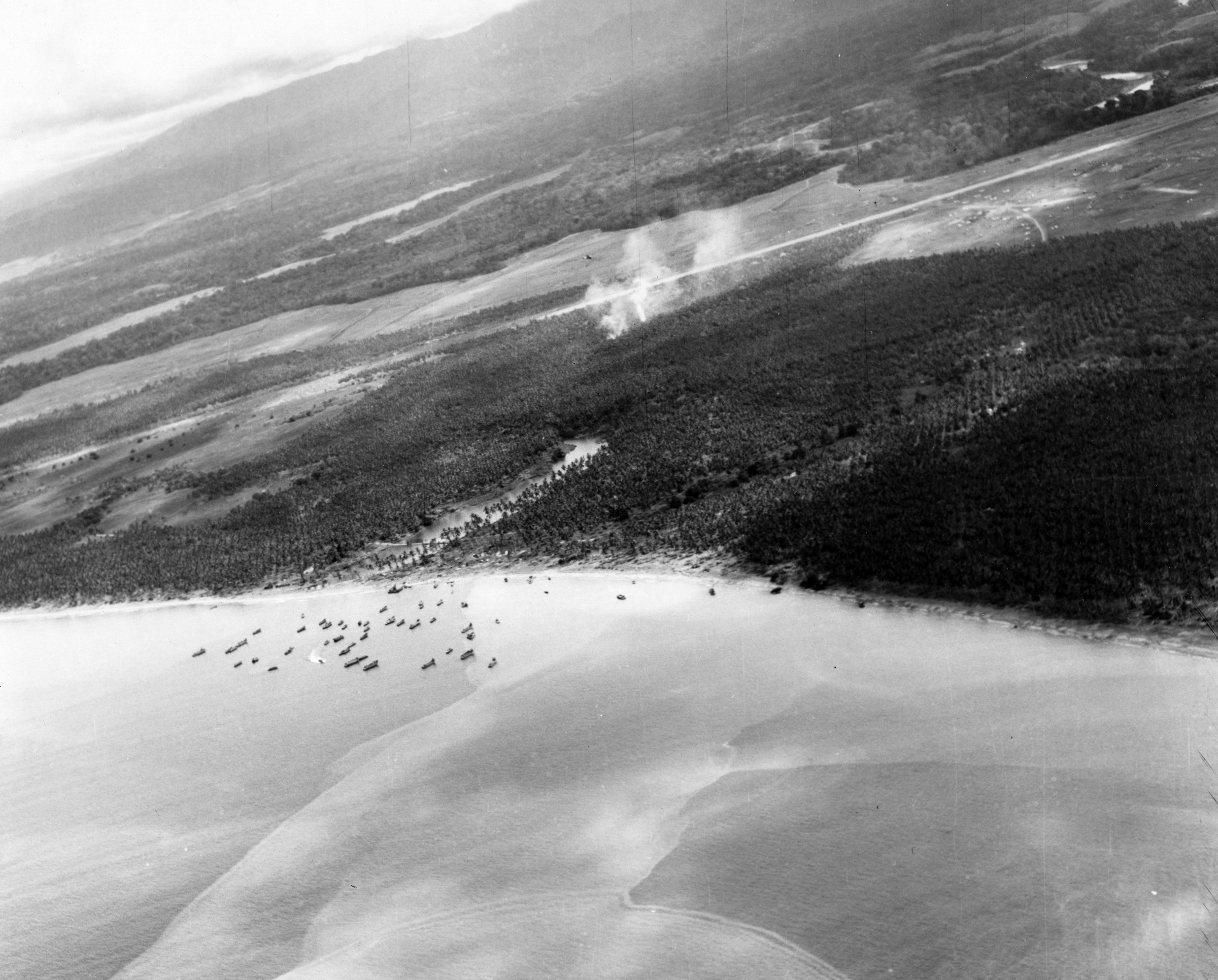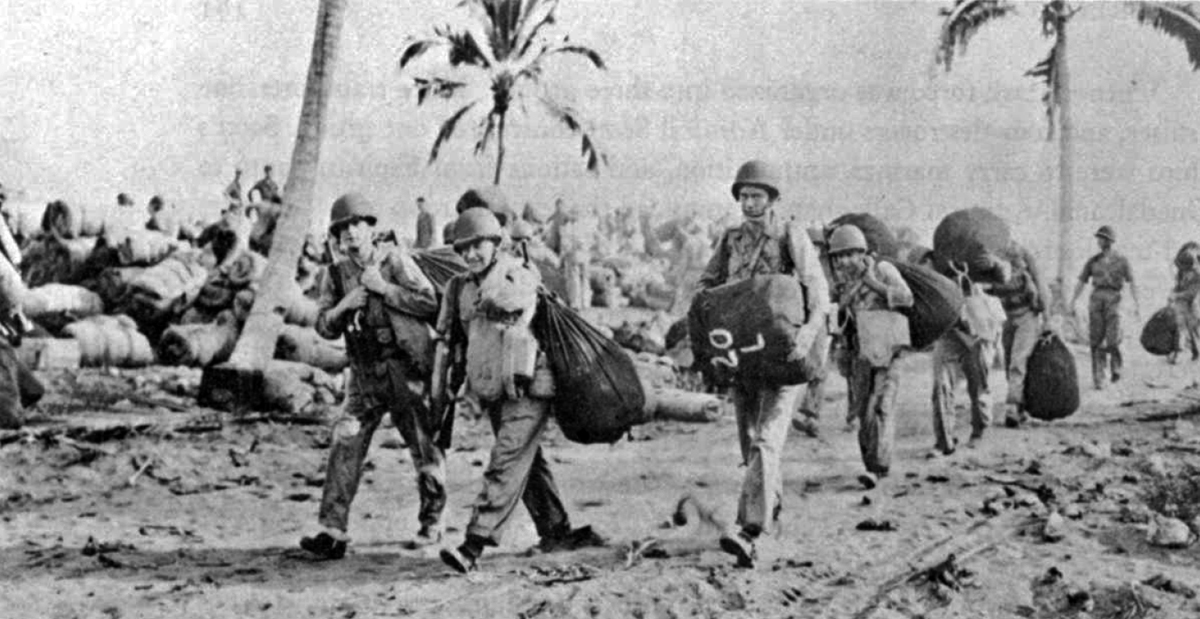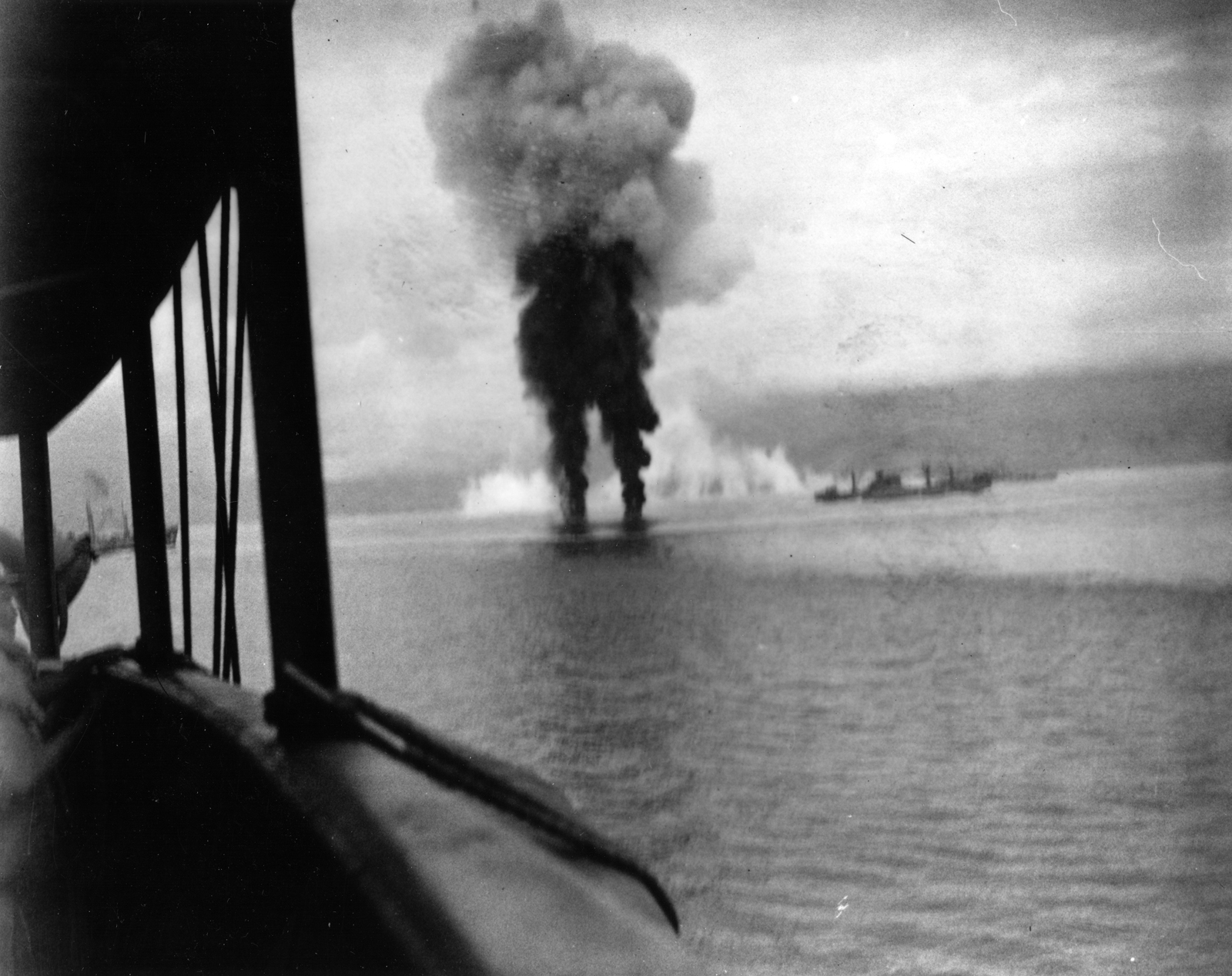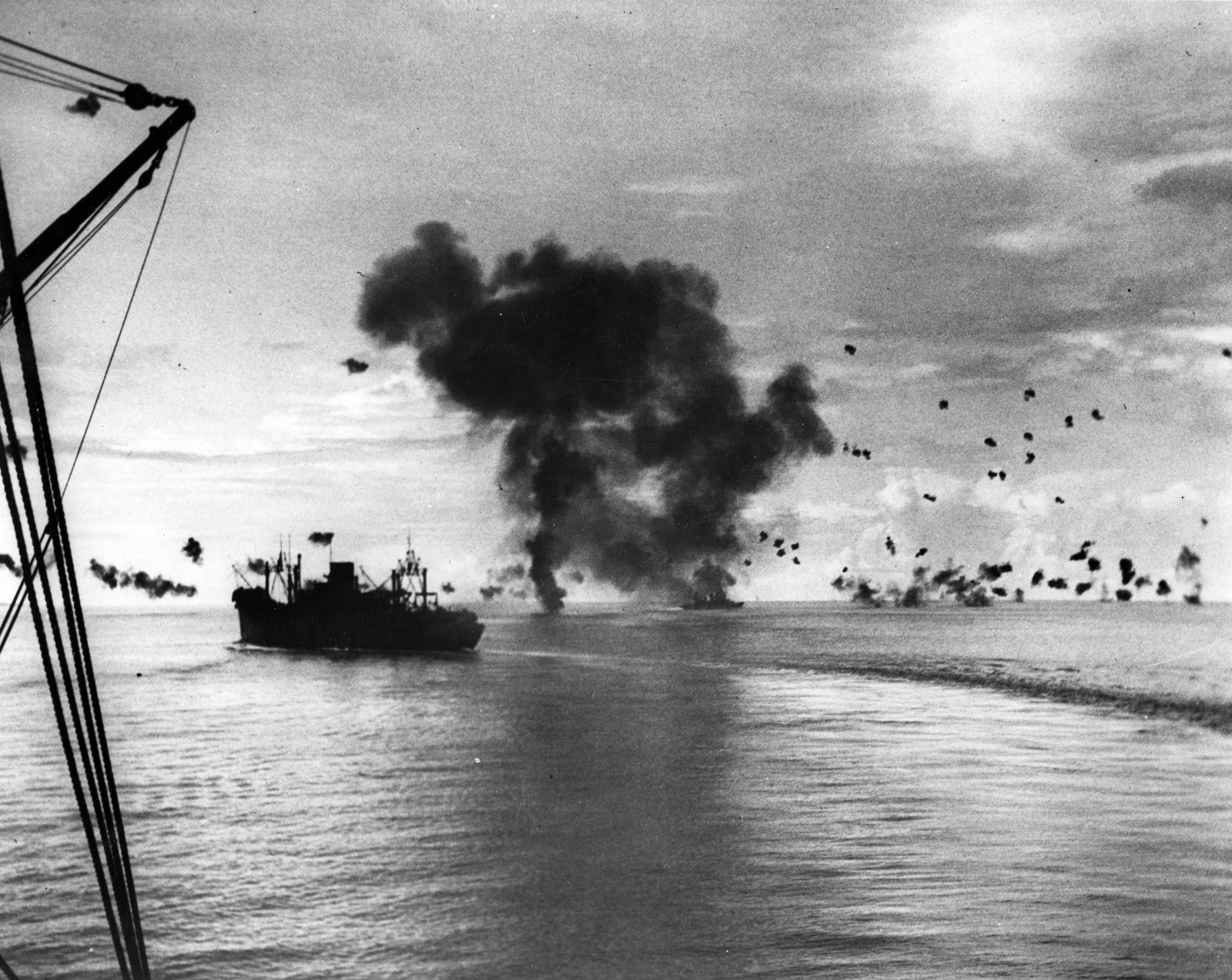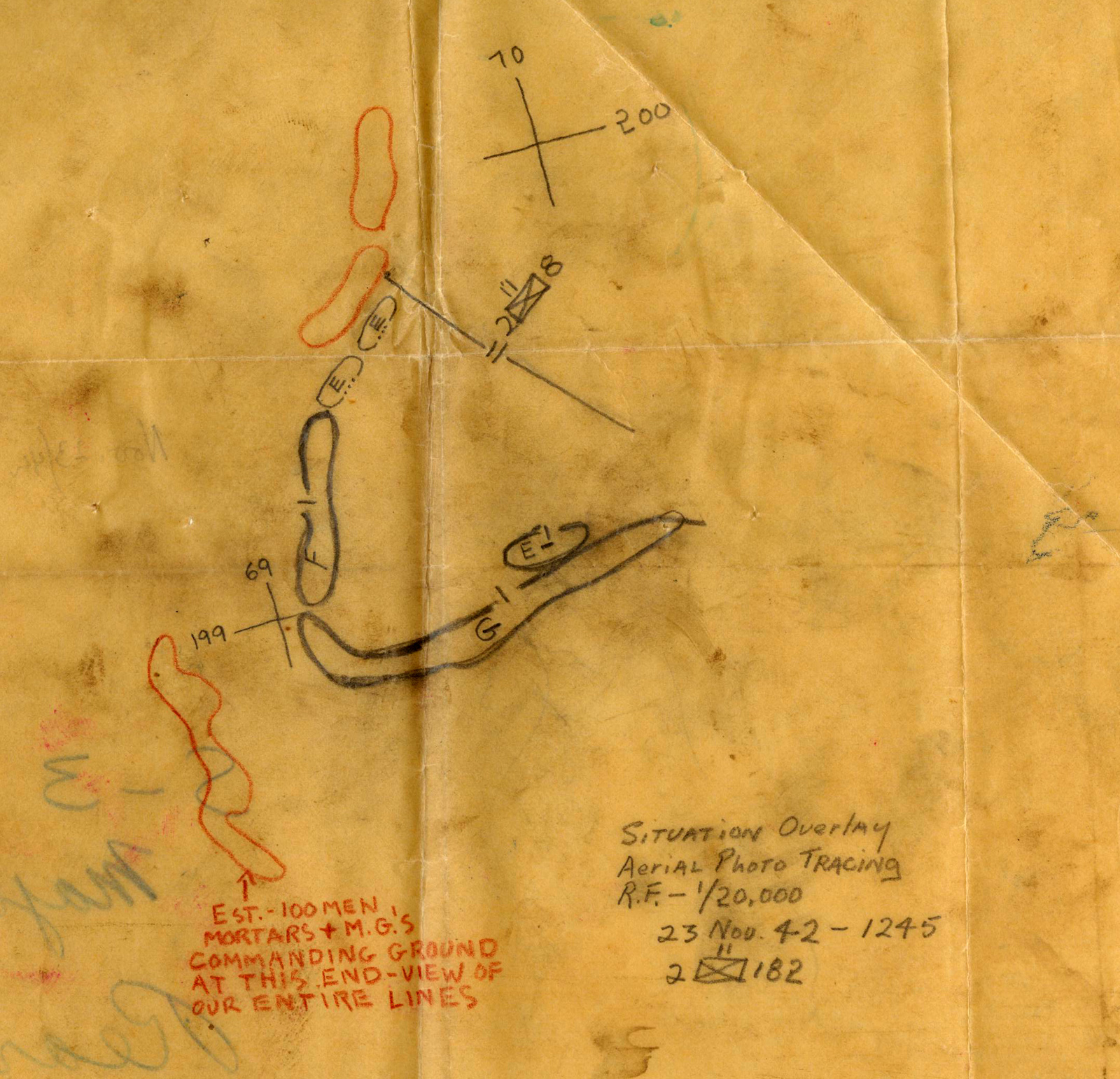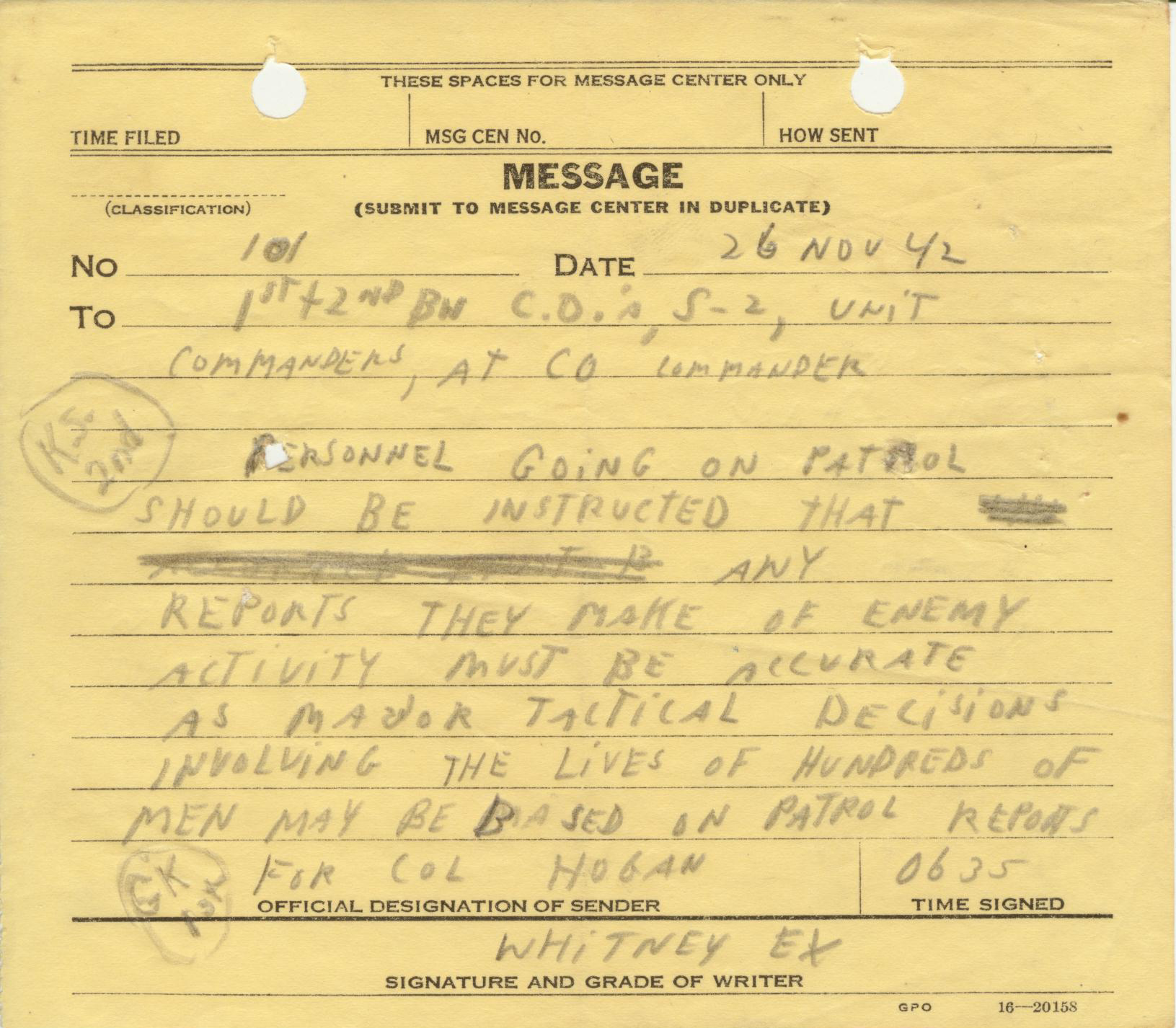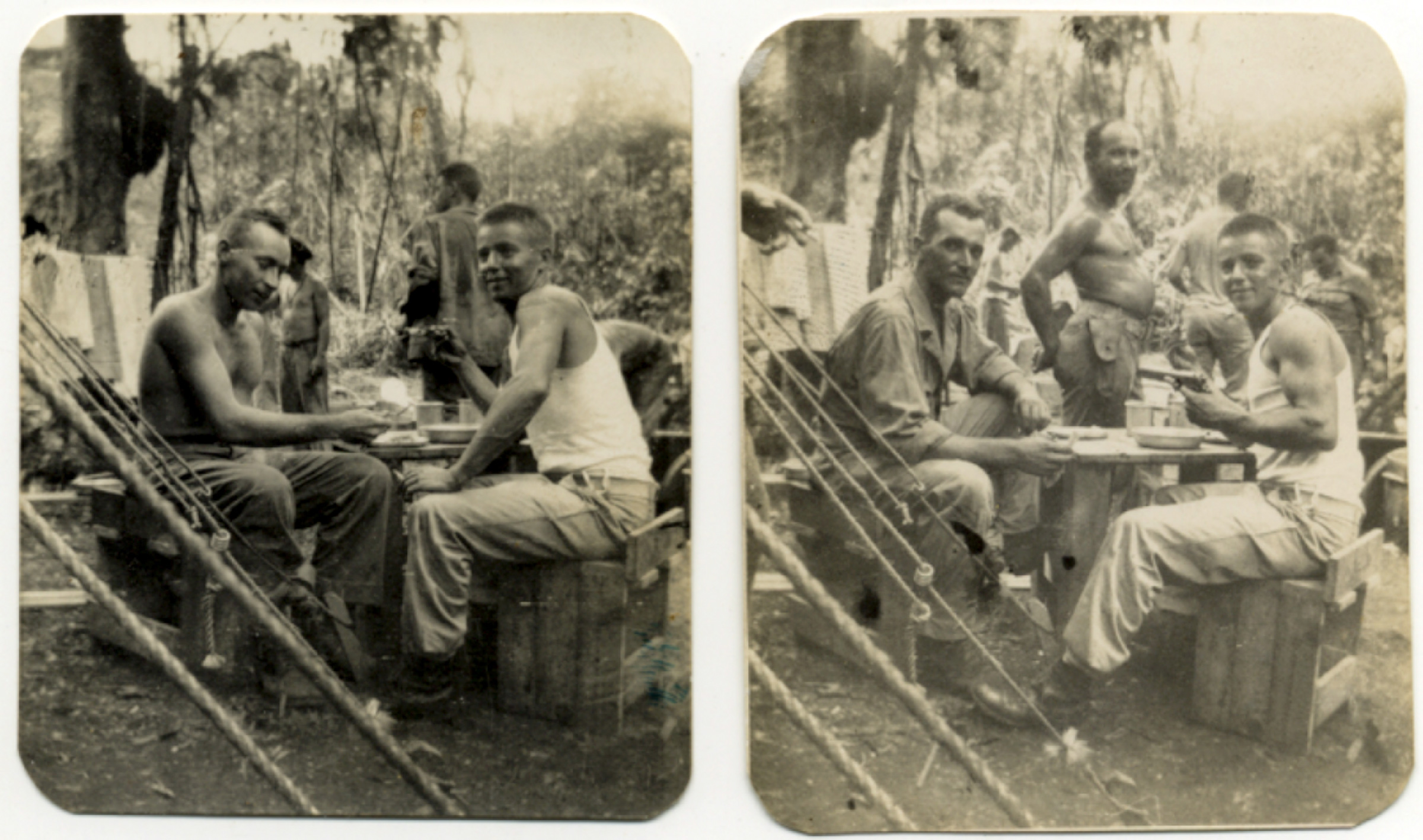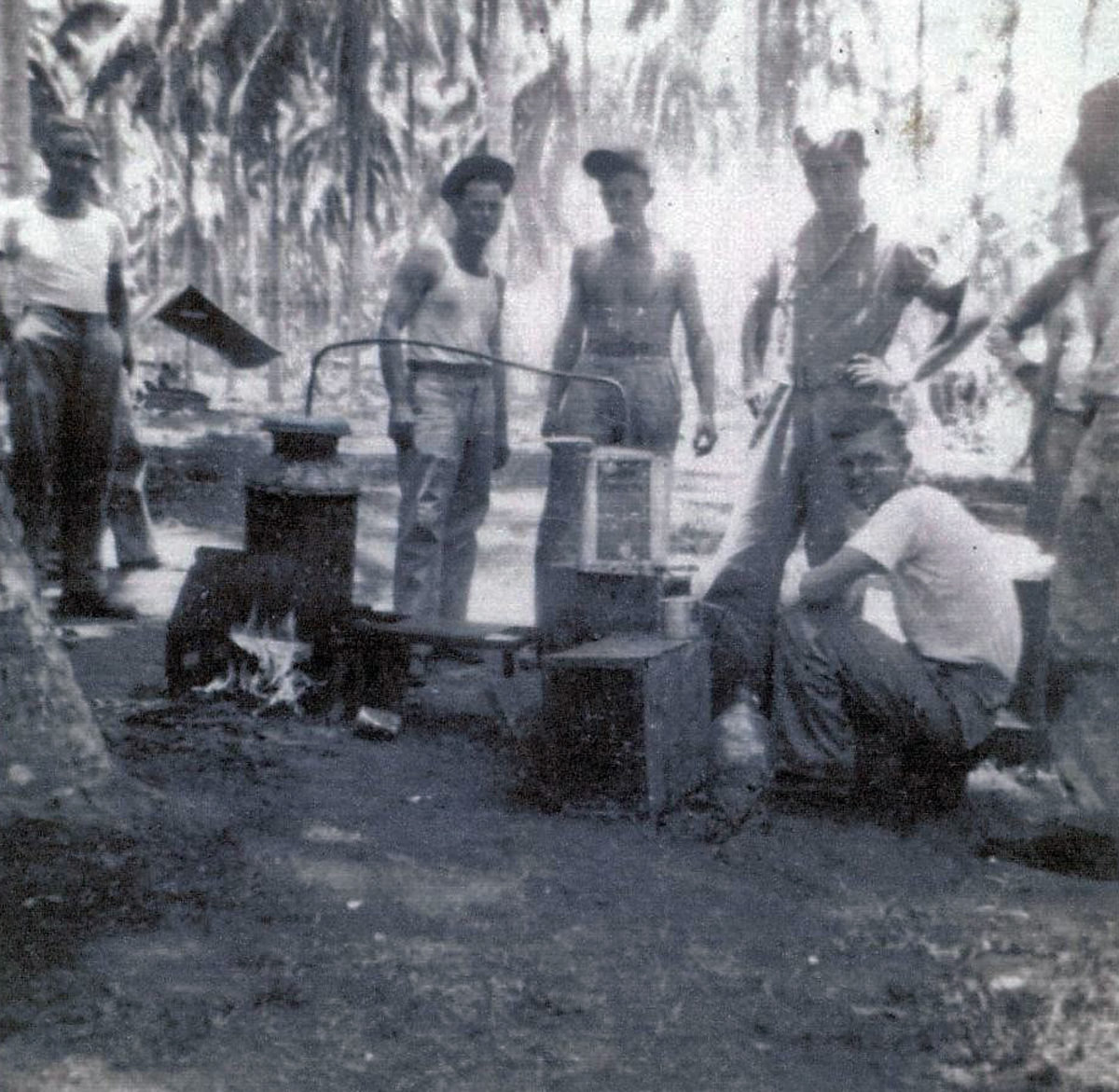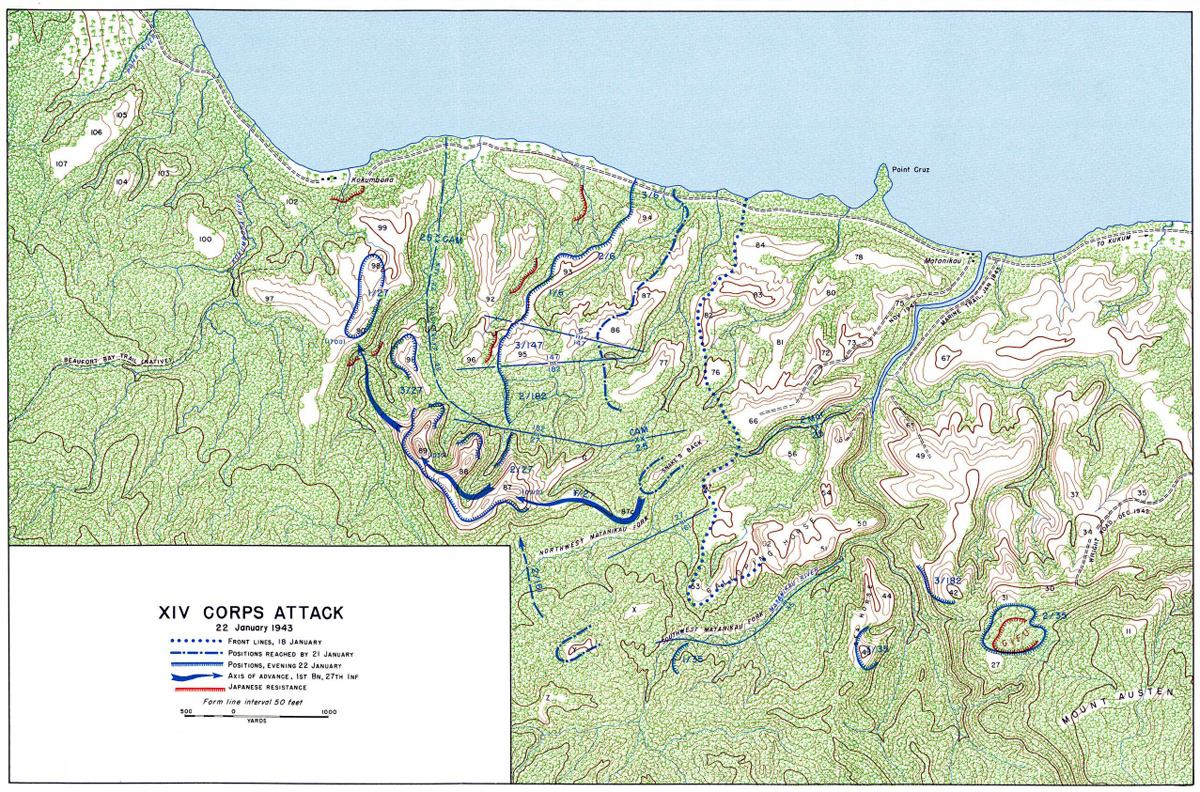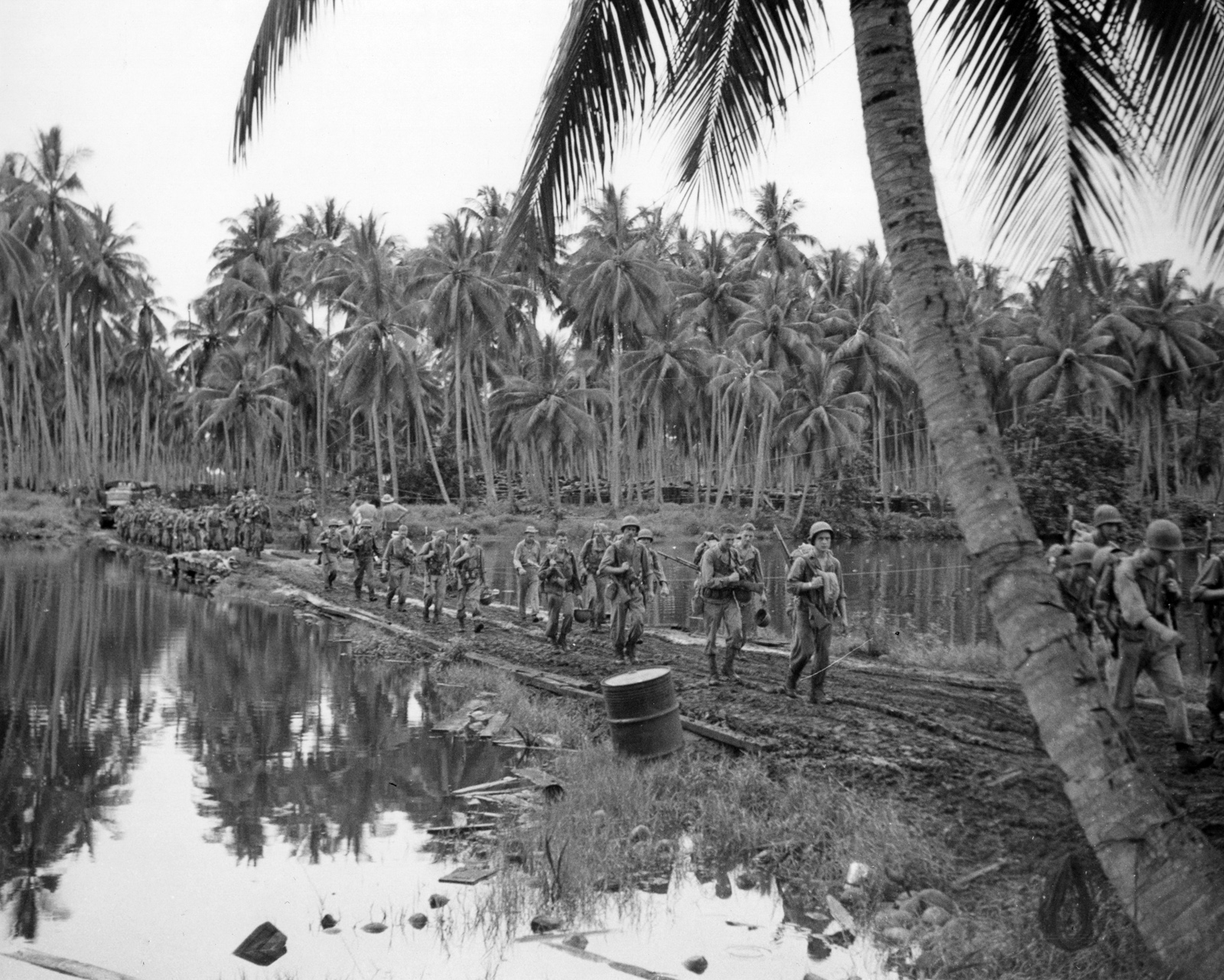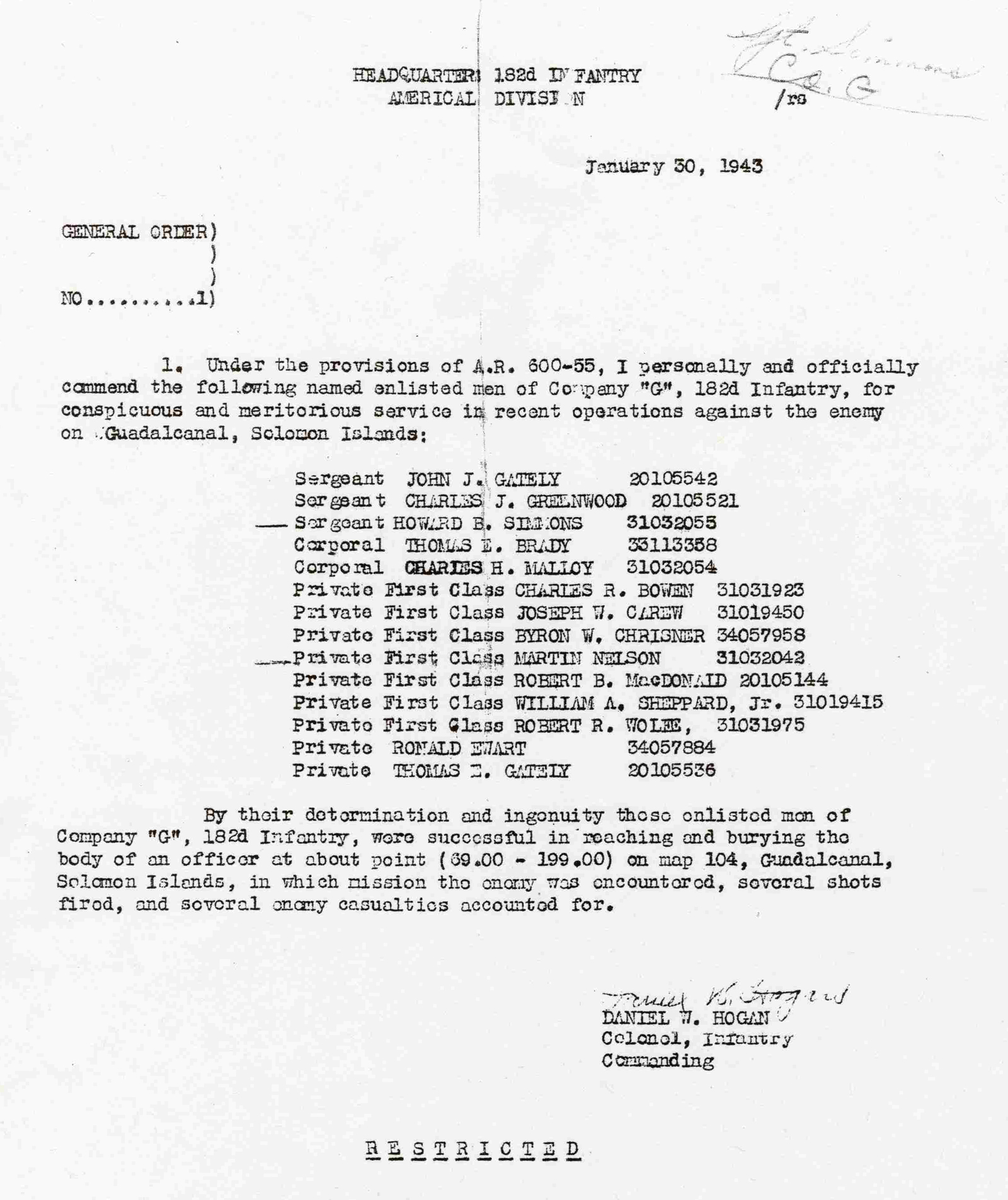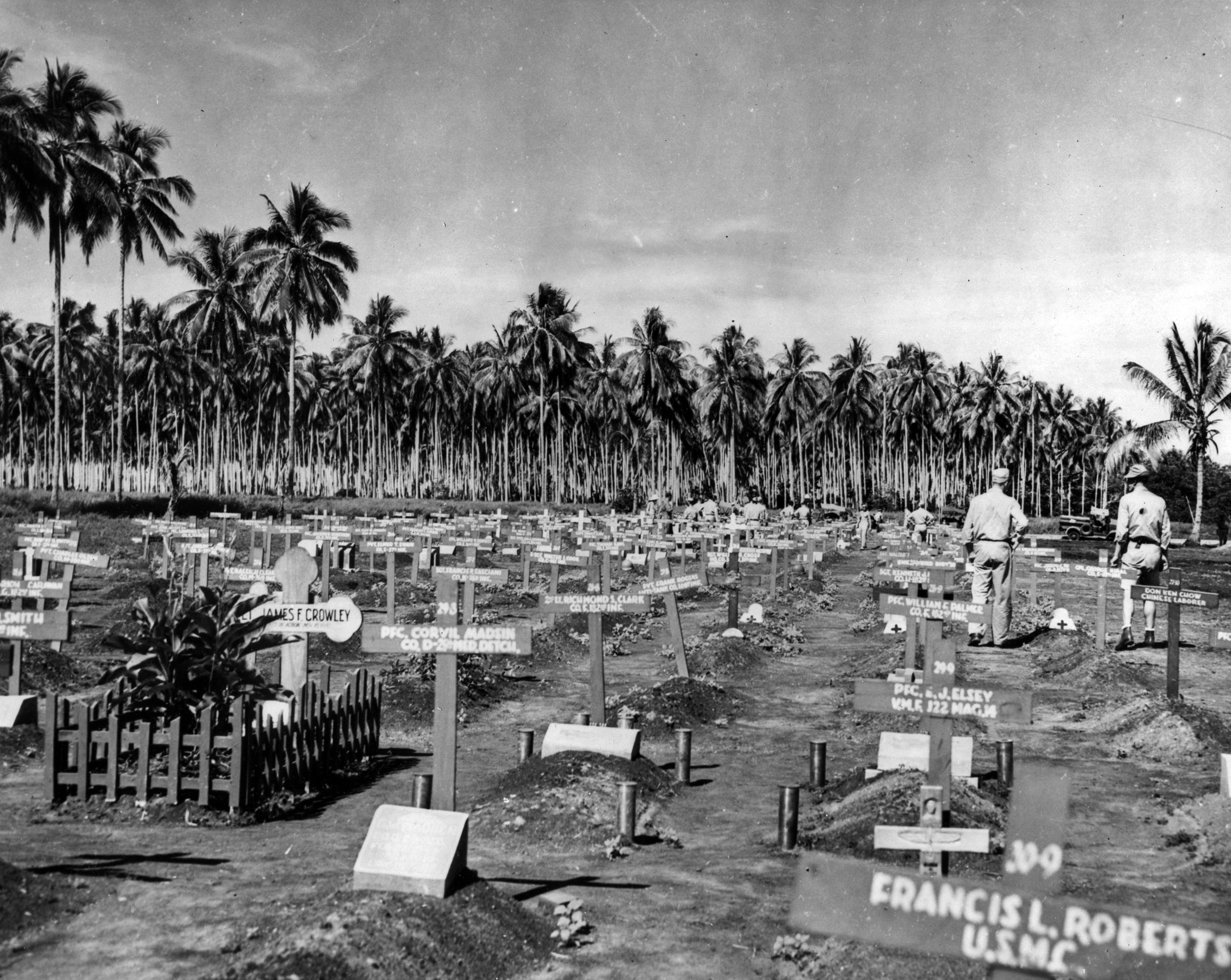On the morning of 12 November 1942, after a week at sea from New Caledonia, the convoy bearing the soldiers of the 182nd Infantry arrived at Lunga Point on the northern shore of Guadalcanal, and began to unload at Kukum Beach (see Google Map here). Aerial Photo #1 was taken in November 1942, but it is unclear whether or not this is the 182nd Infantry landing. In the background, the terrain of Guadalcanal can be seen clearly. Hugging the coastline are neat rows of coconut groves from pre-World War II plantations. Inland, flat coastal plains give way to steep hills and soaring mountain peaks. Henderson Field, the key objective of the campaign (captured early on by the Marines) can be seen at right.
The men of the 182nd arrived safely at Guadalcanal, and immediately began unloading and organizing supplies on the beach. Photo #2 shows soldiers (possibly of Company L, judging by the label on the soldier’s duffel bag) in process of unloading. It was only a matter of hours before the stark reality of war hit the men of Company G, as they were moving supplies on the beach. A swarm of Japanese fighters and bombers appeared in the sky, taking aim at the convoy the soldiers had just left. In Photo #3, taken from the transport USS President Adams, smoke rises from Japanese aircraft shot out of the sky. The Japanese aerial attack was hit hard by American land, sea, and air defenses, with reports indicating that only 1 of 16 planes survived. Men of the 182nd even claimed a kill. In Photo #4, the transport USS President Jackson can be seen maneuvering to sea. The cruiser USS San Francisco lurks in the background, having just been hit by a Japanese plane. The air is full of flak bursts and smoke.
Despite victory in the air on 12 November, a far more dangerous foe was advancing towards the American positions on Guadalcanal. A huge Japanese task force, full of reinforcement troops, and led by two powerful battleships, arrived in the vicinity of Guadalcanal that evening.Tremendous naval action transpired over the next 3 days and nights, including short range combat between battleships from both sides. Despite tremendous losses, American forces were able to turn back the Japanese reinforcements, and sink their two battleships, in the waters that came to be known as Iron Bottom Sound. The American position on Guadalcanal was at last firmly established. Soldiers of the 182nd observed these awe inspiring night exchanges, noting that the sky looked like the Fourth of July.
After a few days on the coast of Guadalcanal, on 18 November the 182nd Infantry began the trek into the inland hills. The march in the steep, overgrown terrain was difficult, and the soldiers were not used to the tropical conditions. Ed Monahan recalled that he served as the lead scout for the march. The soldiers established defensive positions atop Hill 66, seen just to the left of center in Photo #5. After establishing positions on Hill 66, Company G sent out a detail to fill canteens at a water hole. This detail was ambushed by a sizeable Japanese force. The first day of combat was a brutal one for the company. Five men were wounded, and two were reported Missing in Action. It was later confirmed that both men (2nd Lieutenant James Crowley and Private Lloyd Williams) had been killed. Details of this first combat action can be read in this report.
It quickly became apparent that the Japanese were entrenched ahead of the 182nd, and would defend their ground stubbornly. Advances were rebuffed with casualties. By late November, the lines had become fixed and a stalemate ensued. But the Japanese forces on the island were cut off, both from reinforcements, and more importantly from resupply. They were slowly starving to death. The map overlay in Photo #6 shows the position of Company G and other units from the 182nd. Items marked in red are the estimated positions of the enemy. Map overlays were sketched on semi-transparent paper, which could then be lined up with a map, using the numbered cross mark to align it properly.
Field radios were still in their infancy in the early part of the war, and telephone wire strung between outposts was still a common manner of communication. The army traveled with tons of paper and forms, both to disseminate orders, and to record events. The memo in Photo #7, dated 26 November, reminds officers of the 182nd that their men out on patrol had a critical responsibility to accurately report observations of enemy activity.
Army food was generally pre-packaged such as K Rations, but on holidays, the men sometimes ate like kings. That holiday season, Father Laurence Brock wrote home to the people of the Boston area, to let them know what a great holiday meal the men of the 182nd had enjoyed. Company G men can be seen celebrating Christmas 1942 in the two frames of Photo #8. Life on Guadalcanal was generally difficult, and much of the time was spent in foxholes on the lines. But behind the lines, there was time for fun and relaxtion. In Photo #9 from Tony Dziuszko, soldiers of what is presumably Company G eagerly await the finished product of their homemade still.
By early 1943, American forces had developed a plan to drive overland, westwards towards Cape Esperance. Allied forces had established control of the sea and air around the island, and this final campaign was designed to crush the remaining Japanese forces on the island. But the Americans were unaware that the Japanese were simultaneously planning a secret, organized retreat towards Cape Esperance, with a stealthy evacuation by sea. The Americans pushed west, while the Japanese slowly retreated. In the post-war Army map seen in Photo #10, the various units involved in the westward advance are labeled in blue. The 182nd Infantry Regiment can be seen towards the center of the offensive. During this final phase of the campaign, the 182nd Infantry along with other Army and Marine units was consolidated into what was known as the “CAM” (Combined Army and Marine) Division. Marching over steep hills and through dense jungle, the CAM Division steadily pushed west, meeting varying levels of resistance, as the Japanese covered their retreat.
With strong gains being made towards the west, the 182nd returned to the rear area to secure the perimeter at the end of January. In Photo #11, an unidentified Army unit marches on Guadalcanal on 30 January 1943, with Ed Monahan in the middle of the photos, wearing a floppy jungle hat, and not carrying a pack or rifle. By early February, other units finishing off the Allied offensive reached Cape Esperance, thus securing the northeast coast of the island. Unfortunately, thousands of Japanese troops had safely evacuated, to fight another day. But Guadalcanal was at last secure.
Guadalcanal had been a long, difficult struggle, but it proved the turning point of World War II in the Pacific. It had been a terrible learning experience for the Army, Marines, and Navy, with inexperience leading to many casualties on land, sea, and air. The men who served with the 182nd while it was attached to the First Marine Division during their first month on the island were later authorized to wear the prestigious Presidential Unit Citation. Several men from Company G were commended for “conspicuous and meritorious service” (see Photo #12). Five men from Company G were killed during their time on the island, and many others wounded. In addition to combat casualties, disease took a terrible toll on soldiers on Guadalcanal. In the cemetery shown in Photo #13, the graves of two soldiers killed in action can be seen at far left. 2nd Lieutenant James Crowley’s grave is enclosed in a small fence, while the marker for Private First Class Marion Carawan can just be made out at the far left edge of the photo.
Next Chapter: Fiji: Rest and Recuperation

